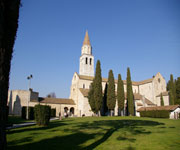Aquileia one of the largest and wealthiest cities of the Early Roman Empire, was destroyed by Attila in the mid-5th century. Most of it still lies unexcavated beneath the fields, and as such it constitutes the greatest archaeological reserve of its kind. The patriarchal basilica, an outstanding building with an exceptional mosaic pavement, played a key role in the evangelization of a large region of central Europe. Aquileia was one of the largest and most wealthy cities of the Early Roman Empire. By virtue of the fact that most of ancient Aquileia survives intact and unexcavated, it is the most complete example of an Early Roman city in the Mediterranean world. The Patriarchal Basilica Complex in Aquileia played a decisive role in the spread of Christianity into central Europe in the early middle Ages.

Continent: Europe
Country: Italy
Category: Cultural
Criterion: (III)(IV) (VI)
Date of Inscription: 1998
Aquileia was a major trading centre
Aquileia was founded by the Romans as a Latin colony in 181 BC in the north-eastern corner of the plain of the Po as an outpost against Gallic and Istrian barbarians. It quickly became a major trading centre, linking central Europe with the Mediterranean. By 90 BC it had been elevated to the status of municipium and its citizens were accorded full rights of Roman citizenship. Its wealth resulted in the town being endowed with many magnificent public buildings, and the private residences of its rich merchants were opulently decorated.










No comments:
Post a Comment